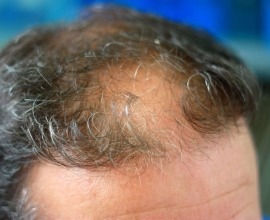The Origin and Progress of Hair Loss Treatment
Throughout history, many bizarre medicinal treatments and even fashion trends arose out of the concern for hair loss. Some of the wackiest attempts to slow down a receding hairline have ranged anywhere from Ancient Egyptian crocodile fat mixtures and boiled porcupine hair serum to Grecian treatments via castration. When Julius Cesar gave up treatment, he took up wearing a laurel wreath around the head, and when King Louis XIII of France lost hope, he invested in a periwig. In the early 1900s, thermocaps and helmet-vacuum pumps became all the rage until a Japanese dermatologist thought it a good idea to treat burn victims by transplanting hair follicles from other places of the body onto any lost patches of hair. In took nearly two more decades for the procedure to gain popularity in treating baldness but it was a big leap forward, leading us to our modern, and more natural looking, procedures of today.[1]
The 1950s-80s hair transplantation technology
Dermatologist Dr. Norman Orentreich initiated the development of hair grafting, or plugs, as a cosmetic procedure in the United States back in the 50s and, thereon forward, became the-guy to go to for performers and Hollywood stars over the years. While the procedure was still in its infancy, and it worked, you could compare the look to that of a shoddy hair trimming on a Barbie doll that now has to unfortunately sport a scalp half-dotted with holes. This is because, as Orentreich explained, the transplanted hairs continue to grow as they would prior to harvesting and, mind you, the 4mm diameter of these plugs were much larger than what you would see today.[2][3][4]

Techniques then progressed towards follicular unit transplantation (FUT), strip harvesting and micrografting, but post-operative areas appeared either too thin, too pluggy or healed in precarious ways with varied results. While already leaps and bounds away from any snake-oil hoax, the development of follicular unit extraction (FUE) brought us an even more natural looking system of treatment.
The 1990s-today hair grafting technology
Follicular unit extraction (FUE) was developed in the 1990s by two Australian siblings, Dr. Ray Wood and Dr. Angela Campbell. Their innovative technique extracted follicular units one-by-one from the donor area with only fine needles, ranging somewhere between 1.5-2mm in diameter. Scarring still occurred, so they punched out even smaller units between 0.6-1mm and hit the sweet spot. The scarring became almost indiscernible to the naked eye. Since then, equipment has improved and manufacturers jumped on board to develop a range of sophisticated tools to limit scarring even further.[5]
New-age FUE treatments
Doctors performing the modern FUE treatments available today extract individual follicular units that consist of one to four hairs with only local anesthesia and a tiny punch tool. Over the course of a single day, a surgeon could transplant an upwards of 3000 grafts to achieve a great look, but at the expense of it requiring deft hands and much more time. This procedure is therefore, on a typical basis, more expensive than the strip method of follicle unit transplantation.

In addition to having more capable surgeons in this field, nowadays, robotic devices have thankfully been developed to facilitate extraction procedures, like to maintain a healthy temperature and moisture level so that transplantation success rates increase. The last thing anybody wants is to pay an enormous amount of cash for a procedure that accidentally kills off some of your healthy hair.
This is why we have incorporated only the latest hair transplantation technology into our FUE procedures. With Artas® robotic technology and Smartgraft methods, we guarantee a head of hair to last. Send us a request today.
Sources:
[1] Cohen, Jennie. “9 Bizarre Baldness Cures.” History, A&E Television Networks, 22 Aug. 2018, www.history.com/news/9-bizarre-baldness-cures.
[2] Singer, Natasha. “Norman Orentreich, 96, Force Behind Hair Transplants, Dies.” The New York Times, The New York Times Company, 21 Feb. 2019, www.nytimes.com/2019/02/21/business/dr-norman-orentreich-dead.html.
[3] Shahmalak, Asim. “A Guide to Hair Transplantation.” The PMFA Journal, Pinpoint Scotland Ltd., 2017, www.thepmfajournal.com/features/post/a-guide-to-hair-transplantation.
[4] “History of Hair Transplant Surgery.” Bernstein Medical - Center for Hair Restoration, Bernstein Medical, 24 Oct. 2019, www.bernsteinmedical.com/hair-transplant/resources/history/.
[5] Shahmalak, Ibid.














